
This is a list of properties and districts listed on the National Register of Historic Places in Rhode Island. As of May 29, 2015, there are more than 750 listed sites in Rhode Island. All 5 of the counties in Rhode Island have listings on the National Register.
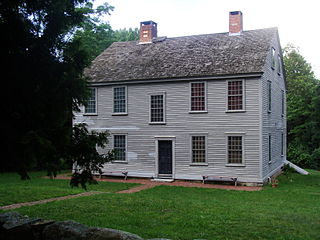
The General Nathanael Greene Homestead, also known as Spell Hall, is a historic house at 20 Taft Street in Coventry, Rhode Island. It was the home of American Revolutionary War general Nathanael Greene from 1770 to 1776, and was owned afterwards by his brother Jacob Greene and his wife Margaret. The house is owned and operated by the General Nathanael Greene Homestead Association, a non-profit organization, and was opened as a museum in 1924.

The Bicknell–Armington Lightning Splitter House is a historic house at 3591 Pawtucket Avenue in East Providence, Rhode Island. The house is of a distinctive type, a "Lightning Splitter", of which only a few instances exist in the Providence area. It is a wood-frame structure with a steep two-story gable roof. Records suggest that the house was constructed about 1827, but architectural evidence suggests it was extensively altered in the 1850s. The main entrance and the interior has a simplified Greek Revival styling. The house was listed on the National Register of Historic Places on November 28, 1980.

See also Daggett House, Slater Park, Pawtucket RI, built about the same time, by Nathaniel's father John.

The James Dennis House is an historic house located at 3120 Pawtucket Avenue in East Providence, Rhode Island. This two-story wood-frame house was built sometime in the 1870s, and is a fine local example of Queen Anne Victorian style. Its most prominent features are a square tower with pyramidal roof, and a decorated porch that wraps around three sides. Although Pawtucket Avenue once had a significant number of such houses lining it, most have been demolished or significantly altered.

The South Central Falls Historic District is a historic district in Central Falls, Rhode Island. It is a predominantly residential area, densely populated, which was developed most heavily in the late 19th century. It is bounded roughly by Broad Street to the east, the Pawtucket city line to the south, Dexter Street to the west, and Rand Street and Jenks Park to the north. It has 377 contributing buildings, most of which were built before 1920. The district was added to the National Register of Historic Places in 1991.
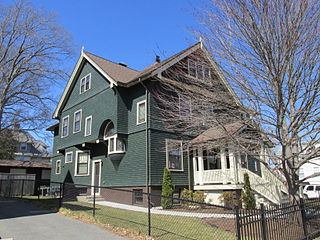
The E. A. Burnham House is an historic house at 17 Nickerson Street in Pawtucket, Rhode Island. It is a 2+1⁄2-story wood-frame structure, with a cross-gabled hip roof plan. Its exterior is finished in wood shingles, with decorative Gothic Revival bargeboard, finials, and other elements. The building's interior contains elaborately carved woodwork, most of which has survived conversion of the building to multiple units. The house was built in 1902 for Eugene Burnham, a local businessman, and is one of the few known designs of local architect Albert H. Humes. The property's garage, which is stylistically similar to the house, may be one of the oldest in the city.
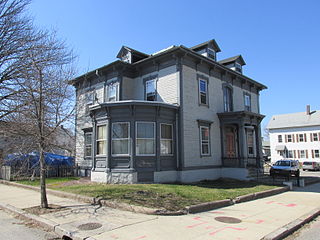
The Childs–Brown House is an historic house in Pawtucket, Rhode Island. It is a two-story wood-frame structure, roughly square in shape, with a low-pitch hipped roof broken by dormer roofs. An ell extends to the rear of the house. Both the eaves and the roof of the front porch exhibit heavy brackets typical of the Italianate style. The interior also retains Italianate style in its woodwork, most prominently in the semi-elliptical main stairway. Built in 1868–69 for Alfred L. Childs, an ice dealer, it was for a number of years owned by members of the Brown family prominent in Rhode Island civic and economic life.
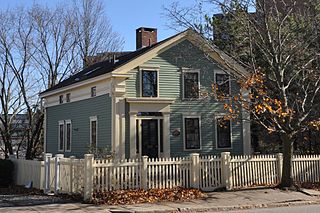
The Lorenzo Crandall House is an historic house in Pawtucket, Rhode Island. It is a 2+1⁄2-story wood-frame structure, built in 1848–49 for Lorenzo Crandall, a carpenter. It features modest Greek Revival styling, including corner pilasters, a wide banded cornice, and molded window caps. It is a well-preserved example of a type of housing that was once quite common in Pawtucket, but is no longer.

The Fifth Ward Wardroom is a historic meeting hall at 47 Mulberry Street in Pawtucket, Rhode Island. It is a single-story red brick building, with a low-pitch hipped roof. Basically rectangular, an enclosed entry pavilion projects from the main block. The building was designed by William R. Walker & Son and built in 1886. Originally used as a polling place and meeting hall, it was later used as a school and by veterans organizations before being converted into a single family residence during its National Register of Historic Places nomination. It was listed on the historic register in 1983.

The Foster–Payne House is a historic house at 25 Belmont Street in Pawtucket, Rhode Island. Built in 1878, the two-story multi-gabled house is distinguished by its clapboarded and exterior woodwork and opulent parlors in the interior. The property also has a matching carriagehouse with gable roof and cupola. The house was originally constructed and owned by Theodore Waters Foster, but it was sold to George W. Payne in 1882. The Foster–Payne House is architecturally significant as a well-designed and well-preserved late 19th century suburban residence. It was added to the National Register of Historic Places in 1983.
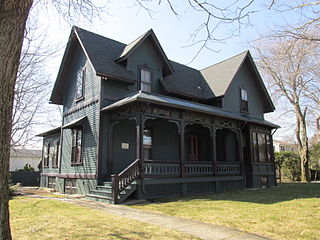
The Louis Kotzow House is a historic house in Pawtucket, Rhode Island. It is a 1+1⁄2-story wood-frame structure, laid out in an L shape. Its exterior is visually busy, with numerous projecting dormer and gable sections, and elaborate woodwork, including bracketed eaves and applied Stick style woodwork on a projecting bay section. Its porch has a delicate jigsawn railing, with a wooden frieze and decorative arches above. The house, built c. 1875, is one of two built by the German Land Cooperative Association, which sought to create a German-speaking enclave in the area.

The Mitchell–Arnold House is a historic house located in Pawtucket, Rhode Island.

The Potter–Collyer House is a historic house at 67 Cedar Street in Pawtucket, Rhode Island. The house, first constructed in 1863, is representative of vernacular architecture of the Pawtucket due to the great modifications to the home which has obscured the original structure of the home. Believed to have begun as a 1+1⁄2-story cottage with a gable roof, subsequent additions and expansions have added a two-story hip-roof addition and greatly altered the floor plan due to enlargement and remodeling. The Potter–Collyer House was added to the National Register of Historic Places in 1983.

The Scholze–Sayles House is a historic house in Pawtucket, Rhode Island. It is a 1+1⁄2-story wood-frame structure, built in 1874–75. It is one of two built by the German Land Cooperative Association, which sought to create a German-speaking enclave in the area. This house is a fine example of Gothic Revival style, and is stylistically similar to the Kotzow House, with a busy exterior that has numerous projecting and gabled sections, and Stick style decoration on a bay window. The interior was extensively redone in 1935 in a Federal Revival style by architect Albert Harkness.

The South Street Historic District encompasses a small enclave of 19th-century houses on South Street between Meadow and Fruit Streets in Pawtucket, Rhode Island. Covering two blocks of South Street, it includes 21 buildings, of which 15 were built before 1850, and the rest before 1900. Most of the houses are 1+1⁄2-story wood-frame structures, with many of the larger ones showing signs of having once been of a similar size. The most common architectural style is the Greek Revival, with notable examples at 19-21 and 37-39 South Street.

The Joseph Spaulding House is an historic house at 30 Fruit Street in Pawtucket, Rhode Island. It is a 1+1⁄2-story wood-frame structure, five bays wide, with a side-gable roof and a large central chimney. It is set in a hillside, and its basement, made of fieldstone, is used as an additional story. Built in 1828, with an ell added in 1850, it is one of the city's least-altered and best-preserved Federal style houses.
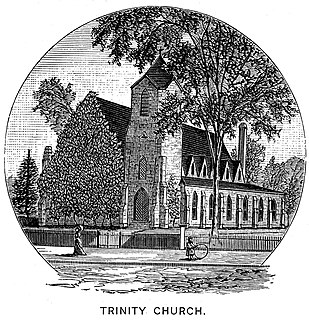
Trinity Episcopal Church was a historic church located at 48 Main Street in Pawtucket, Rhode Island. Built by the Episcopalians, the building was sold to the Catholics in 1977 and became the St. George Maronite Catholic Church within the Diocese of Providence. The church burned down in 2005, and was not rebuilt.
Montgomery House may refer to:

The Downtown Pawtucket Historic District encompasses a major portion of the central business district of Pawtucket, Rhode Island. The city's downtown was developed primarily between 1871 and 1930, covering the period when it grew to become the second-largest city in the state. The district is irregularly shaped, including properties on Montgomery Street south of Manchester, and properties on Exchange, North Union, and Summer streets between Broad and High Streets, as well as a few properties on Main Street and Maple Street east of Park Place. It includes 50 buildings on 14 acres (5.7 ha), built in a cross-section of architectural styles from the late 18th century to the mid-20th century, although the main exterior construction material is brick. Most of the buildings are commercial in use, although there are three houses and a church included in the area.





















